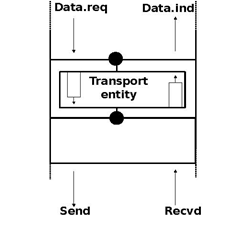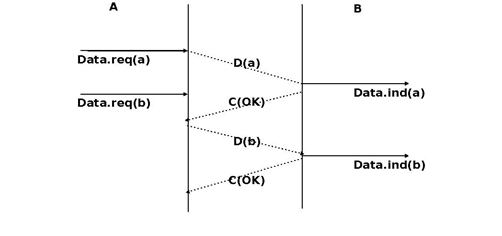The transport layer entity interacts with both a user in the application layer and an entity in the network layer. According to the reference model, these interactions will be performed using DATA.req and DATA.ind primitives. However, to simplify the presentation and to avoid confusion between a DATA.req primitive issued by the user of the transport layer entity, and a DATA.req issued by the transport layer entity itself, we will use the following terminology :
- the interactions between the user and the transport layer entity are represented by using the classical DATA.req, DATA.ind primitives
- the interactions between the transport layer entity and the network layer service are represented by using send instead of DATA.req and recvd instead of DATA.ind
This is illustrated in the figure below.

When running on top of a perfect connectionless network service, a transport level entity can simply issue a send(SDU) upon arrival of a DATA.req(SDU). Similarly, the receiver issues a DATA.ind(SDU) upon receipt of a recvd(SDU). Such a simple protocol is sufficient when a single SDU is sent.
Unfortunately, this is not always sufficient to ensure a reliable delivery of the SDUs. Consider the case where a client sends tens of SDUs to a server. If the server is faster that the client, it will be able to receive and process all the segments sent by the client and deliver their content to its user. However, if the server is slower than the client, problems may arise. The transport layer entity contains buffers to store SDUs that have been received as a Data.request from the application but have not yet been sent via the network service. If the application is faster than the network layer, the buffer becomes full and the operating system suspends the application to let the transport entity empty its transmission queue. The transport entity also uses a buffer to store the segments received from the network layer that have not yet been processed by the application. If the application is slow to process the data, this buffer becomes full and the transport entity is not able to accept anymore the segments from the network layer. The buffers of the transport entity have a limited size 1 and if they overflow, the transport entity is forced to discard received segments.

To solve this problem, our transport protocol must include a feedback mechanism that allows the receiver to inform the sender that it has processed a segment and that another one can be sent. This feedback is required even though the network layer provides a perfect service. To include such a feedback, our transport protocol must process two types of segments :
- data segments carrying a SDU
- control segments carrying an acknowledgment indicating that the previous segment was processed correctly
- the header that contains one bit set to 0 in data segments and set to 1 in control segments
- the payload that contains the SDU supplied by the user application
The transport entity can then be modelled as a finite state machine, containing two states for the receiver and two states for the sender. The figure below provides a graphical representation of this state machine with the sender above and the receiver below.

The above FSM shows that the sender has to wait for an acknowledgement from the receiver before being able to transmit the next SDU. The figure below illustrates the exchange of a few segments between two hosts.

- 2980 reads






